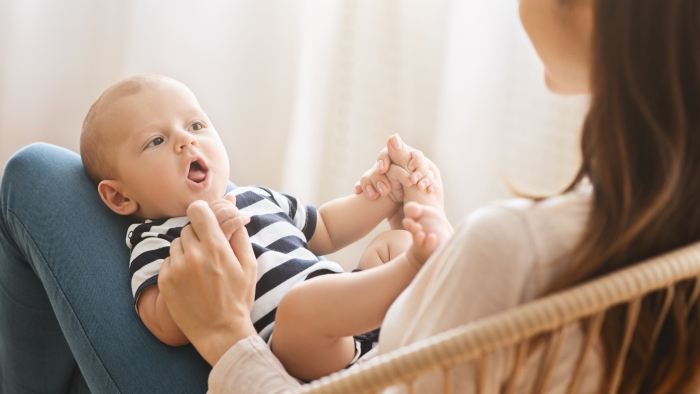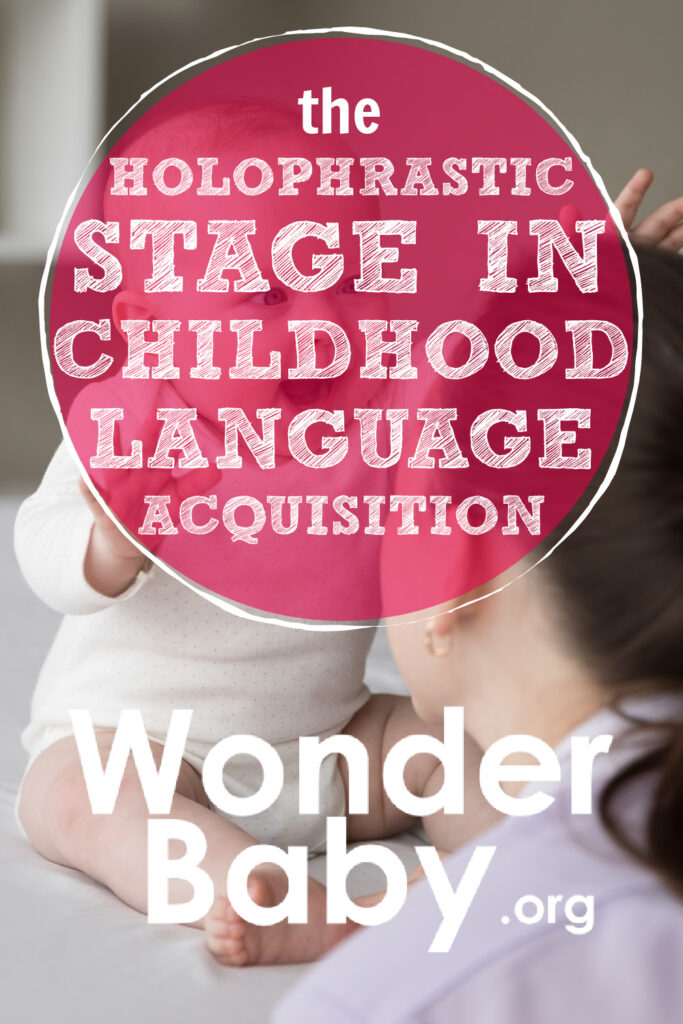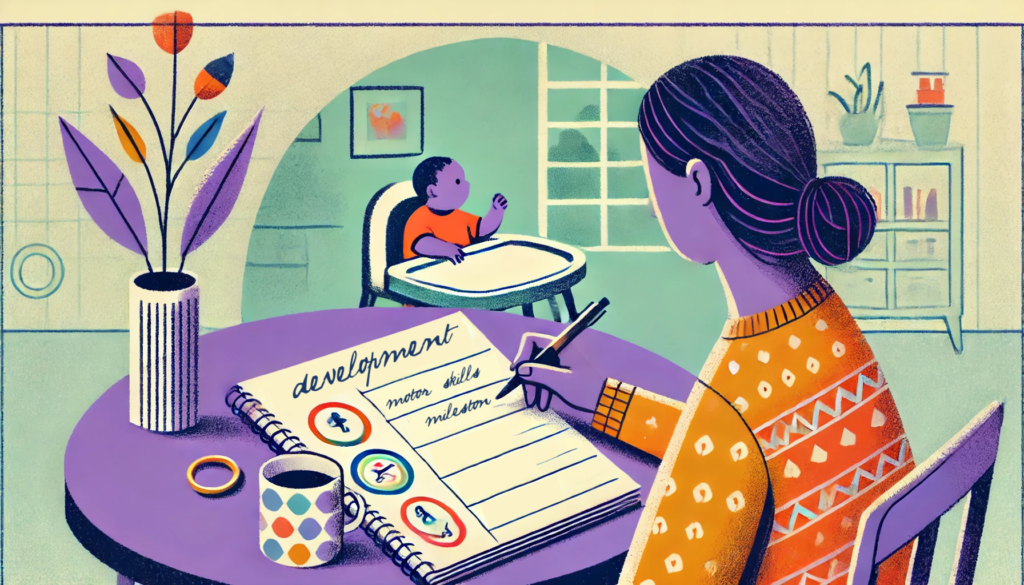The Holophrastic Stage in Childhood Language Acquisition

- The holophrastic stage occurs when a child starts to use one word to express an idea.
- This is the third of the language acquisition stages and develops between nine and 18 months of age.
- Children start to use volume and intonation to express their message with one word.
- Children will not have all their speech sounds developed yet, so many of the words will be approximations, such as “ba” for “bottle.”
- Modeling language during playtime with your child is a great way to help children build their language skills.
After my first two children said “dad” before “mom,” I was determined to help my third child turn the tables. I sang songs about “moms” and modeled, “ma-ma-ma–ma—mom’s the best!” Did it work? No. The first word that she used was “da” for her daddy. While I was 0 for 3, it’s something my husband and I still laugh about today.
The emergence of a child’s first words is undoubtedly one of the most special times for parents. The point in which a baby’s playful babbling stage moves to the use of a recognizable word to express a complex idea is referred to as the holophrastic stage of children’s language development.
What Is the Holophrastic Stage?
The holophrastic stage, or one word stage, is one of the main stages of language acquisition, occurring between nine and 18 months of age. During this time, babies begin to use single words to express multiple meanings, such as requesting, labeling, or commenting.
In the holophrastic stage, or the “one word stage,” children use one word to express multiple meanings and ideas. It is the third stage of child language acquisition. It follows the pre linguistic stage (cooing and vocal play), and the babbling stage (combining various consonants and vowels that don’t contain meaning).
While parents delight in the holophrastic stage, it is exciting for the child, as well! Their vocabulary is growing, and with it the scope of their thoughts. At this stage, children use one word to express different ideas. For example, a child may say the word “milk,” to express, “I want milk,” or, “oh no, my milk fell!” This one word has multiple meanings to the child.
To communicate their full idea, children begin practicing changes in volume and intonation, using their voice to make a statement or ask a question, to express frustration or delight.
At this one word stage of language development, children begin to understand the phonology, or sound rules of their native language and can hear the differences between individual sound segments. The sounds produced may be limited, but the child hears and understands the differences in the sounds others say.
While a child may be only using one word, by using it to express various ideas they are expanding their lexical and syntactic knowledge. In doing so, they are gradually building the foundation for later developing grammar.

Examples of Holophrastic Speech
It is easier for children to learn vocabulary than understand and use the nuances of sentence structure. This is why the holophrastic stage typically includes content words from the child’s immediate environment.
We can categorize words in the order they develop.
| Nouns |
|
| Verbs |
|
| Adjectives |
|
| Rejection Words |
|
| Social Words |
|
While children are getting better at using different consonant and vowel sounds, their sound system is far from being fully developed. Therefore, first words may sound like word approximations, containing the sounds appropriate for their age.
Sound Development by Age
The American Speech Language Hearing Association (ASHA) outlines the ages when most English-speaking children develop sounds.
- By 3 months: makes cooing sounds
- By 6 months: babbles simple consonant vowels such as “ba, ma, puh”
- By 1 year: combines babbling syllables such as “baba, mama, upup”
- By 3 years: consonants “m, n, h, w, p, b, t, d, k, g, f” are used in words
- By 4 years: adds “y, v” sounds in words (At this time, there may still be age appropriate errors with the sounds “s, sh, ch, j, ng, th, z, l, r.”)
Why Is the Holophrastic Stage Critical in Language Acquisition?
Through their use of single words to express different ideas, children are expanding and growing their language skills. While using one word may seem simple, there is much happening in this language learning stage. For example:
- Children are expanding their vocabulary.
- Children are developing their phonological awareness and articulation skills, or speech sounds.
- Children are developing grammar through their use of a single word and the adult’s expansion of that word. For example, if a child says, “car!” and mom responds, “There is a car,” the child is learning through language modeling from the adult.
This one word stage is also an important step in building confidence and self-esteem. When others respond to and expand on their language, the child realizes they can affect those around them. It encourages them to continue to communicate and explore other ways to communicate their message.
At What Age Does the Holophrastic Stage Occur?
The holophrastic stage occurs between nine and 18 months of age with some variation. It begins around nine months and starts with the child referring to something basic in their environment.
As they progress through this stage, by around 18 months of age this one word begins to hold more meaning. Instead of just labeling “mama,” they may use this word to ask “Where’s Mama?” or to say “I want mama!” They may use the same sound for several words, such as “ba” for “ball and “bottle.”
Another characteristic of this stage is overgeneralization, where one word will encompass an entire category. For example, a child might call all four-legged animals “dog.” As their vocabulary grows, overgeneralization phases out.
Play time with your child is very important at this stage. Children use your feedback and language expansion to build onto their language foundation. As their language becomes more complex, their play skills will also become more complex.
They will move from handling objects to see how they move to using them for pretend play. Providing experiences for your child to use both structured and open ended play will provide plenty of great language experiences for them to learn from.

How Long Does the Holophrastic Stage Last?
This one word stage typically lasts around six months. During this time a child is building language and articulation skills, practicing with stress, volume and intonation, and preparing to enter the two word stage of language development.
Toward the end of this stage, a child will experience a vocabulary burst, a cognitive stage in which they realize that all objects have a name. They become increasingly curious and begin to ask, “what’s that?” throughout the day.
They also begin to play around with combining two words as they continue to learn that language has power. By saying “mommy sit,” they learn that they can direct mom’s actions more specifically. In this stage, children are also developing sequential reasoning, which helps with understanding how to sequence word combinations. This is a dramatic leap forward in the child’s vocabulary learning.
What Comes After the Holophrastic Stage?
This vocabulary growth and understanding of a predictable sequence will help the child move to the telegraphic stage, or early multiword stage around 24–30 months of age. During the telegraphic stage, a child will start combining more words with minimal grammar rules, making their speech sound like an old time telegraph. Children continue to gain control over their articulators, using more accurate sounds during language acquisition.
The holophrastic stage is a fun and exciting time for both the child and the parents. As the child’s thoughts expand, their use of language continues to grow. Soon you will be hearing some very inventive combinations which can be hilarious and endearing. It’s fun to see their personalities grow during this time of development. Take notes for the baby book, this time goes by quickly!
Please remember that each child develops at his or her own pace. If you ever have questions or concerns about your child’s speech and language development, please see a speech-language pathologist. Early intervention is the best key to success for speech and language delays, so reach out with questions!

Related Posts

Development, Special Needs
How to Track Milestones for Developmentally Delayed Babies
Parents of developmentally delayed babies can explore practical tools and strategies to track milestones, celebrate progress, and support their child’s unique developmental journey.

Fine and Gross Motor
5 Alternatives to Tummy Time for Babies with Motor Development Challenges
Does your baby struggle with tummy time due to motor development challenges? These alternatives to tummy time will offer the same benefits.

Development
Should Twins Share a Room?
Wondering if your twins should share a room? We’ll explore the pros and cons of room-sharing for twins right here before you make your decision.